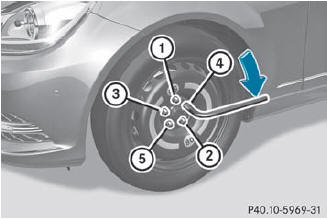Lowering the vehicle
 Turn the crank of the jack counterclockwise
until the vehicle is once again
standing firmly on the ground.
Turn the crank of the jack counterclockwise
until the vehicle is once again
standing firmly on the ground.
 Place the jack to one side.
Place the jack to one side.

 Tighten the wheel bolts evenly in a
crosswise pattern in the sequence
indicated (1 to 5). The tightening torque
must be 96 lb-ft (130 Nm).
Tighten the wheel bolts evenly in a
crosswise pattern in the sequence
indicated (1 to 5). The tightening torque
must be 96 lb-ft (130 Nm).
WARNING
Have the tightening torque checked
immediately after a wheel is changed. The
wheels could come loose if they are not
tightened to a torque of 96 lb/ft (130 Nm).
 Turn the jack back to its initial position and
store it together with the rest of the tirechange tool kit in the trunk/cargo
compartment.
Turn the jack back to its initial position and
store it together with the rest of the tirechange tool kit in the trunk/cargo
compartment.
 Transport the defective wheel in the trunk/cargo compartment.
Transport the defective wheel in the trunk/cargo compartment.
or
 Depending on the size of the wheel, you
may also be able to secure the defective
wheel in the spare wheel well. In this case,
you will have to remove the stowage well
casing from the spare wheel well and stow
it securely in the trunk/cargo
compartment.
Depending on the size of the wheel, you
may also be able to secure the defective
wheel in the spare wheel well. In this case,
you will have to remove the stowage well
casing from the spare wheel well and stow
it securely in the trunk/cargo
compartment.
 USA only: when you are driving
with the
emergency spare wheel mounted, the tire
pressure monitoring system cannot
function reliably. Only restart the tire
pressure monitoring system when the
defective wheel has been replaced with a
new wheel.
USA only: when you are driving
with the
emergency spare wheel mounted, the tire
pressure monitoring system cannot
function reliably. Only restart the tire
pressure monitoring system when the
defective wheel has been replaced with a
new wheel.
All wheels mounted must be equipped with
functioning sensors. The defective wheel
should no longer be in the vehicle.
See also:
Derestricting the shift range
- Pull the right-hand steering wheel paddle
shifter.
The shift range is derestricted. ...
Activating/deactivating DSR
Activating
You can only activate DSR if you are driving
at 25 mph (40 km/h) or slower.
– Press button 1.
Indicator lamp 2 lights up.
The following messages appear in the
multifunction displa ...
Safety guidelines for seat belts,
Emergency Tensioning Devices (ETDs)
and air bags
WARNING
- Damaged seat belts or seat belts that have
been subjected to stress in an accident
must be replaced. Their anchoring points
must also be checked. Only use seat belts
installed o ...
